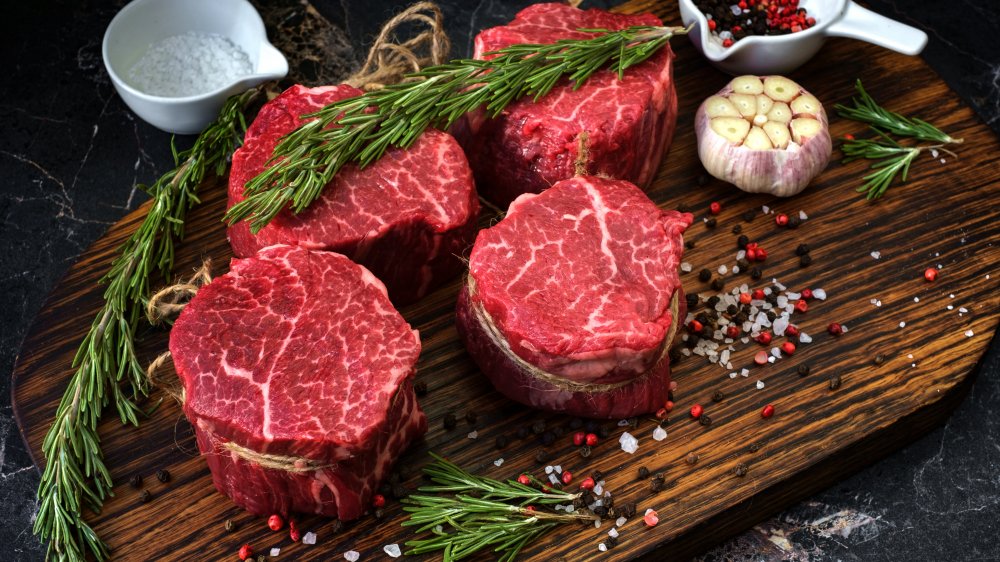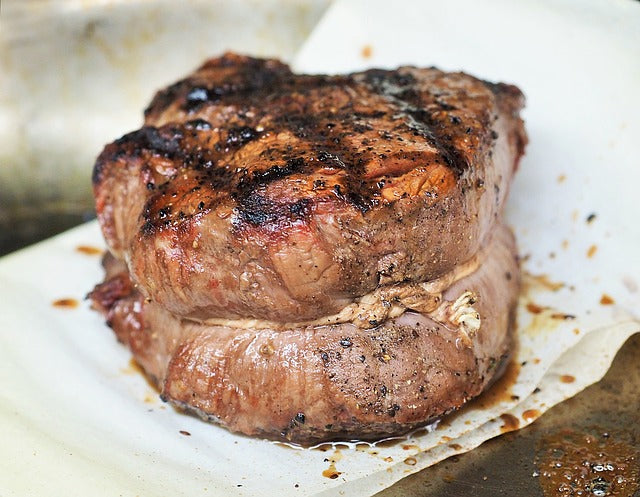Have you ever wondered why filet mignon, the tender and luxurious cut of beef, comes with a hefty price tag? Well, my friend, you’re about to uncover the secrets behind why filet mignon is so expensive. Get ready to dive into the world of fine dining and discover the factors that contribute to its high cost.
You may have heard of filet mignon as the crème de la crème of steaks, known for its remarkable tenderness and melt-in-your-mouth texture. But what exactly makes this cut of meat so special, and why does it come with a premium price? Buckle up, because we’re about to explore the origins and qualities that set filet mignon apart from other cuts.
From the rearing of cattle to the exquisite marbling and intense flavor, there are several factors that contribute to the elevated cost of filet mignon. Whether you’re a food enthusiast or just curious about the world of culinary delights, this intriguing exploration will shed light on the question “why is filet mignon so expensive?” So, let’s get started on this savory journey!
Ever wondered why filet mignon comes with a hefty price tag? Well, there are a few reasons that contribute to its expensive nature. First, filet mignon is cut from the tenderloin, which is one of the most tender and sought-after cuts of beef. Additionally, the supply of tenderloin is limited, further driving up the price. Finally, the butchering process required to extract the filet mignon cut is time-consuming and precise, adding to the overall cost. These factors combined make filet mignon a luxury item on the menu.

Why is Filet Mignon So Expensive?
Filet mignon is renowned for its tenderness, juiciness, and luxurious taste. However, it often comes with a hefty price tag. Have you ever wondered why filet mignon is so expensive compared to other cuts of beef? In this article, we will delve into the factors that contribute to the high cost of filet mignon, from the rearing process to its exceptional culinary qualities. Join us as we uncover the secrets behind the allure of this premium beef cut.
1. The Rarest Cut: Limited Supply, High Demand
One of the main reasons why filet mignon commands a high price is its limited supply and high demand. Filet mignon is extracted from the tenderloin, a muscle located in the loin area of the animal. This muscle is relatively small, making up only about 2% of the entire carcass. Compared to other cuts like ribeye or sirloin, filet mignon yield is significantly lower, resulting in fewer portions available for consumption. As a result, the scarcity of filet mignon drives up its price in the market.
Furthermore, filet mignon is highly sought after by steak aficionados and is often associated with fine dining and special occasions. Its reputation as the pinnacle of beef cuts and its delectable tenderness have made it a prized choice among discerning steak lovers. The combination of limited supply and high demand creates the perfect environment for price escalation, making filet mignon a luxury indulgence.
The scarcity of filet mignon is further amplified by the fact that certain regions, such as Japan’s Kobe beef, produce filet mignon of exceptional quality that elevates its price even further. These factors contribute to the exclusivity and premium value of filet mignon.
2. The Tenderloin: A Muscle of Perfection
The filet mignon’s outstanding tenderness and melt-in-your-mouth texture can be attributed to its location within the animal. The tenderloin muscle resides in an area of the animal that experiences minimal movement, resulting in a muscle with an exceptionally fine grain and minimal connective tissue. This translates to an incredibly tender and smooth texture when cooked to perfection.
To maintain its tenderness, the tenderloin requires extra care during the rearing process. It is essential to ensure the highest quality of feed, a stress-free environment, and meticulous handling to preserve its delicate nature. The stringent standards and additional resources needed to rear cattle for filet mignon contribute to its elevated price.
Additionally, the tenderloin muscle produces various cuts, including the filet mignon. The demand for other cuts, such as Chateaubriand or Tournedos, further reduces the supply of filet mignon available, further driving up its price.
3. Culinary Perfection: The Ultimate Dining Experience
Filet mignon is renowned for its culinary qualities, which make it a top choice for many steak connoisseurs. Its exceptional tenderness and mild flavor are desirable attributes that contribute to its high price. When prepared properly, filet mignon can deliver a dining experience like no other.
Due to its lean nature, filet mignon requires precision cooking to maintain its tenderness and prevent dryness. This level of culinary expertise and attention to detail adds to the overall value of the cut. Chefs and culinary enthusiasts appreciate the precise techniques required to cook filet mignon to perfection, further enhancing its reputation and price.
The allure of filet mignon lies not only in its tenderness but also in the fact that it pairs effortlessly with a variety of flavors. The mild taste of filet mignon allows for endless creative possibilities in seasoning and accompanying sauces, making it a versatile canvas for culinary exploration. This versatility adds to the appeal and exclusivity of filet mignon in fine dining establishments and high-end restaurants.
So, why is filet mignon so expensive?
We now understand that the high price of filet mignon can be attributed to a combination of factors. The limited supply, high demand, and exceptional qualities of the muscle contribute to its exclusivity and premium value. The rareness of the cut, coupled with the tenderness of the tenderloin and its exceptional culinary qualities, result in a luxury beef experience that comes at a price.
Insights into Filet Mignon Prices
While filet mignon is undeniably a treat for the palate, it is important to consider personal preferences and budget when making dining decisions. Consider exploring other cuts of beef that offer great flavor and tenderness at a more accessible price point. Strip steak, ribeye, and sirloin are all excellent alternatives that provide a more budget-friendly yet equally flavorful steak experience. Remember, indulgence comes in many forms, and the joy of savoring a well-prepared steak is not limited to filet mignon alone.
Whatever your choice may be, understanding the factors that contribute to the price of filet mignon allows for a greater appreciation of its luxury status. So, the next time you enjoy a succulent filet mignon, savor each bite knowing that you’re experiencing a truly special and exclusive cut of beef.
Key Takeaways: Why is Filet Mignon So Expensive
- Filet mignon is expensive because it comes from a highly prized and tender part of the cow called the tenderloin.
- The tenderloin is a small cut of meat, which makes it limited in availability and drives up the price.
- Filet mignon is known for its exceptional tenderness and rich flavor, making it a popular choice among steak enthusiasts.
- Raising and feeding cows for premium beef can be a costly process, contributing to the higher price of filet mignon.
Frequently Asked Questions
Welcome to our Frequently Asked Questions section on filet mignon prices. If you’ve ever wondered why filet mignon is more expensive than other cuts of beef, you’re in the right place. Read on to find out more about this delicious and luxurious cut of meat.
1. How is filet mignon different from other cuts?
Filet mignon is known for being one of the most tender and flavorful cuts of beef. It comes from the tenderloin, which is a muscle that doesn’t get much exercise, resulting in a tender texture. Its marbling, the fat that runs through the meat, adds to its rich flavor. With its melt-in-your-mouth tenderness, filet mignon is a sought-after choice for steak lovers.
However, what sets filet mignon apart from other cuts, like ribeye or sirloin, is its scarcity. Each cow only yields a small amount of filet mignon, making it a more exclusive cut that demands a higher price. The combination of tenderness, marbling, and limited supply contributes to its higher cost.
2. Does the way filet mignon is raised affect its price?
Yes, the way filet mignon is raised can have an impact on its price. Filet mignon typically comes from high-quality beef, which is often sourced from animals that have been raised with extra care, attention, and sometimes specific diets. These factors can result in a higher cost for the meat.
Additionally, some filet mignon may come from specific breeds of cattle, such as Wagyu or Angus, which are known for their exceptional quality and flavor. These specialty breeds require more time, resources, and expertise to raise, adding to the overall cost of the meat.
3. Are there any other factors that contribute to the price of filet mignon?
Yes, there are other factors that can drive up the price of filet mignon. One significant factor is the cost of production, including the expenses associated with maintaining a high-quality and hygienic environment for the cattle and ensuring their welfare. These costs are then passed on to the consumers.
The cost of transportation is another factor to consider. If the filet mignon needs to travel a long distance to reach its market, the transportation expenses can add up, adding to the overall price. Additionally, if the cut of meat needs to undergo specific aging or preparation techniques, such as dry-aging, this can also impact the final cost.
4. Does the demand for filet mignon affect its price?
Yes, the demand for filet mignon does impact its price. Due to its reputation for tenderness and flavor, filet mignon is often considered a luxurious cut of meat. Its desirability among consumers drives up the demand, and when demand exceeds supply, prices tend to rise. As filet mignon is limited in supply, the high demand can contribute to its premium price tag.
Additionally, the popularity of filet mignon in premium restaurants and high-end steak houses further drives the demand. These establishments often charge a higher price for filet mignon due to its sought-after status, contributing to the perception of filet mignon as an expensive cut of meat.
5. Are there any cost-saving alternatives to filet mignon?
Absolutely! If you’re looking for a more economical option, there are alternatives to filet mignon that can still deliver delicious flavor and tenderness. Cuts like ribeye, sirloin, or striploin offer great taste and texture at a lower price point. These cuts are also more widely available, making them a cost-effective choice for steak enthusiasts.
Furthermore, exploring different cooking methods, such as marinating or slow cooking tougher cuts of beef, can create flavorful and tender results without breaking the bank. Experimenting with different cuts and cooking techniques can open up a world of affordable and delicious options for your next steak night.

The Most Expensive Steak- Filet/Filet Mignon
Summary
So why is filet mignon so expensive? Well, it all comes down to a few key factors. Firstly, the cut of meat itself is highly prized for its tenderness and flavor. Secondly, the process of raising, feeding, and butchering the cattle that produce filet mignon is costly. Lastly, the supply and demand for filet mignon also play a role in driving up its price. So, while filet mignon may be on the pricier side, it’s all because of its delicious taste and the effort that goes into producing it.
In conclusion, filet mignon is expensive because it is a top-quality cut of meat that is in high demand. The cost accounts for the meticulous care, time, and expertise required to produce this delicious delicacy. So, the next time you enjoy filet mignon, remember that its price reflects the exceptional taste and craftsmanship that goes into it.






